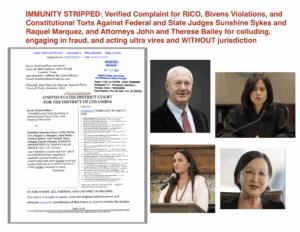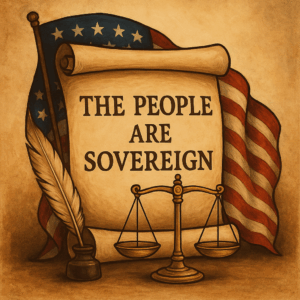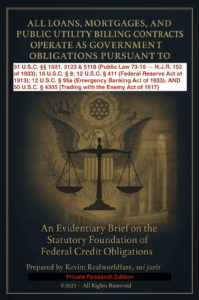Equitable Subrogation along with Natural Law and Trust Law is the Remedy to Stop the Unjust Enrichment. It is for the “Restitution” of our Private God Given Rights which is our PROPERTY. Subrogation means “Substitution”. That’s what the Banksters and the Fictional “STATE” did to our Mothers when they were “deceived” into “Registering” our PROPERTY — Our Equitable Rights and Remedies were Subrogated/Substituted.
This is how they “Presumed” themselves “Creditors”. In other words, they are now Playing Us and We are now Playing “presumed Debtors”.
🔍 The Discovery of Subrogation
It so happens that I found this tool, Ironically called Subrogation, in doing my due diligence in research, that Lawfully Reverses the “Fraud” and the Unjust Enrichment.
Maxim of Equity States:
“Equity aids the vigilant, and not those who slumber on their Rights.”
🧍♂️ The Role of the Living Man/Woman
This can only be done when we the “Living Man/Woman” STOP Volunteering.
Maxim of Equity States:
“Equity will not aid a Volunteer.”
By the way, One cannot mix UCC terms like “Secure Party Creditor” in Equity because we are the original Creditors already by Default without perfecting that position. Equity is not competing for any Lien or Security position.
⚖️ The Function of Surety and Subrogation
Look into Surety Equitable Subrogation further and you will see that every time the Surety Subrogee Creditor, who is also the True Beneficiary of the CQVTrust, Stops Volunteering by Discharging and Settling all Debt Obligations In the Private, Equity steps in and Subrogate[s] the Presumed Creditor/Beneficiary by Operation of Law.
Remember, in Subrogation, a “Subrogor” loses the “Claim” to seek Compensation. I am sure you will understand why that is.
🚪 The Limits of Corporate Fiction
The Corporate Fictions actors cannot do Equity, they have to come alive into the Private Jurisdiction, with “clean hands” to make or to challenge our Rightful Equitable Interest and Title.
As I stated before when I first contacted you, there are a lot of Folks out there teaching Equity and Common Law, yet they do not know anything about Surety/Subrogee Equitable Subrogation Rights. Even when you bring it for their attention, they refuse to do the “research”.
There is only one brother I know of who teaches Exclusive Equity and Subrogation — his name is at Amir_Law Academy.
🚫 The Caution on Mixing Jurisdictions
It is unwise to mix Equity and UCC.
Equity is God’s Law, Law of the Air, is above Land and Sea Law or Man-made Laws. It is Spiritual, in order to do Justice.
🔄 How Subrogation Operates
Simply stated:
When the Surety/Creditor/Subrogee Discharges the “Presumed” Debt “Lien” against our Cestui Que Vie Trust, Substitution/Subrogation takes place by Operation of Law — which means “Restitution” takes place and Recovery of our original position in the Constructive Trust, which is another Equitable Remedy for Breach of Trust.
Maxim of Equity States:
“Equity will not allow Statutes and codes to be used as a Cloke for FRAUD.”
💸 What Instrument Discharges the Lien?
When all of the Equitable Principles and “Rights” are understood — what monetary instrument will I be using as Surety/Subrogee/Creditor to “Pay off”, “Discharge”, or to “Purchase the Lien” against the Estate?
📜 The Promissory Note as Legal Tender
The Bill of Exchange Act 1882 describes the Promissory Note as “Cash”.
This is where I am — to learn how to perfect and write a Lawful Promissory Note as the Maker/Drawer/Indorser.
I am assuming that you have practical knowledge and experience of this operation in Reality, even though it wasn’t by Exclusive Equity.
🪙 The Intersection of Law and Commercial Remedy
The Bill of Exchange Act and HJR 192 together seem to be as good as Gold/Cash.
In conclusion, by simply Discharging the whole Debt with a Promissory Note by the Drawer, Maker, and Endorser as Surety/Subrogee/Creditor, in essence, means it’s subrogation time!!
👥 Understanding the 3-Party Relationship
According to the Bill of Exchange Act, the Bank is the “Drawee and Trustee” with a Fiduciary Duty, in this 3-Party Relationship.
🔚 Final Thoughts
In this construct of fiction layered upon fiction, Equity remains the highest jurisdiction, and subrogation is the lawful key to restoring what was taken through presumption, deception, and silence.
By understanding and applying Surety/Subrogee principles, we step back into our rightful roles — as creditors, as beneficiaries, and as the true parties in interest. When we act with clean hands, in honor, and with perfected security, Equity moves by operation of law, displacing every fraudulent claim and restoring the estate.
“He who comes to Equity must come with clean hands — but once he does, Equity does not sleep.”
The time for waiting is over. The remedy exists. We are the living authority.
Let those with eyes to see and minds to act, do so now.
In remedy, in honor, and in peace.




